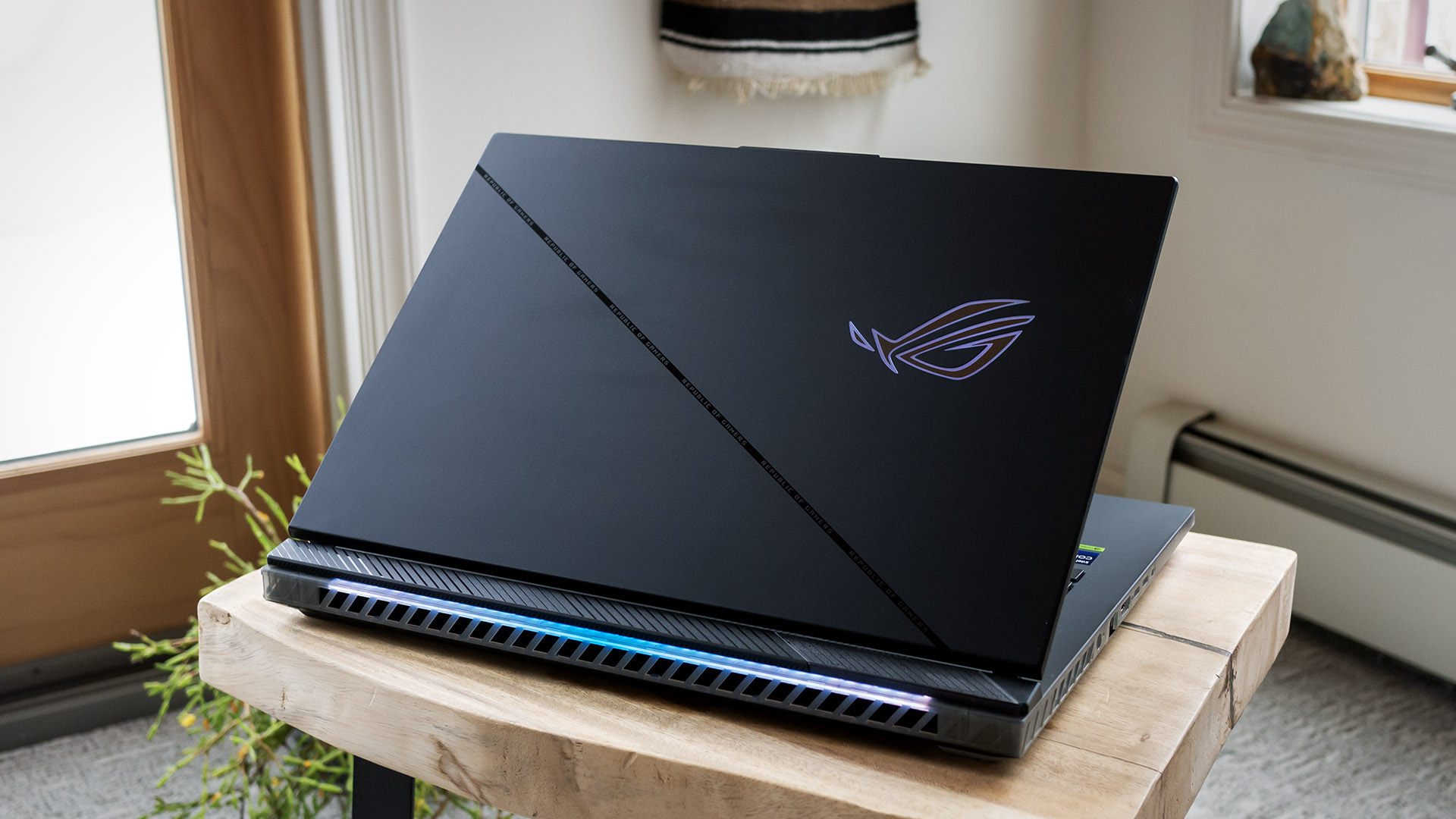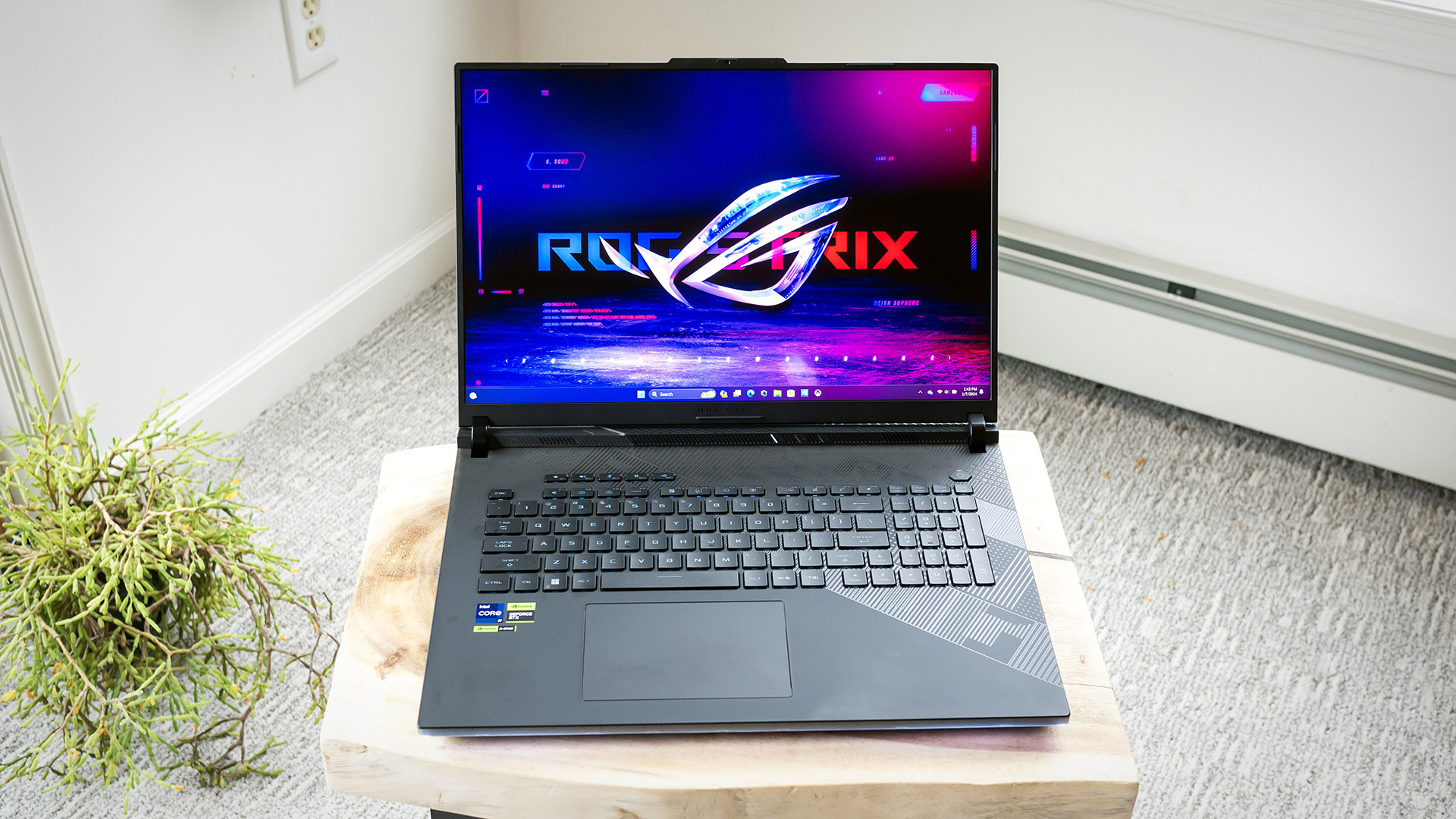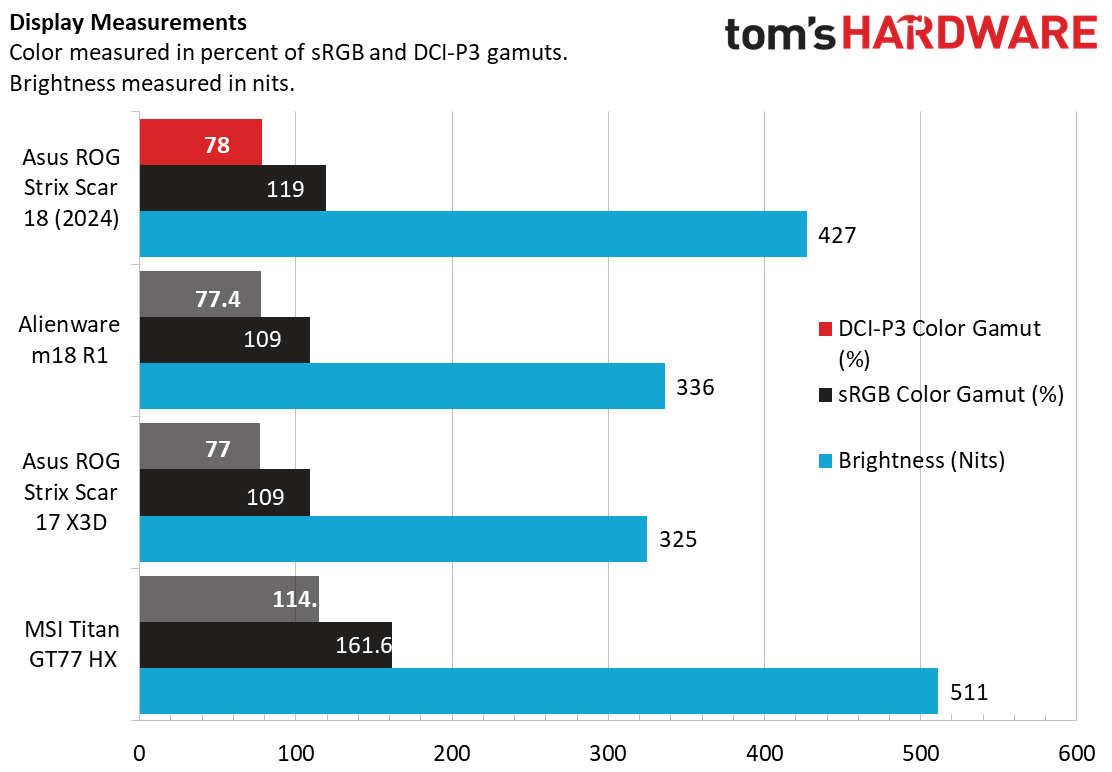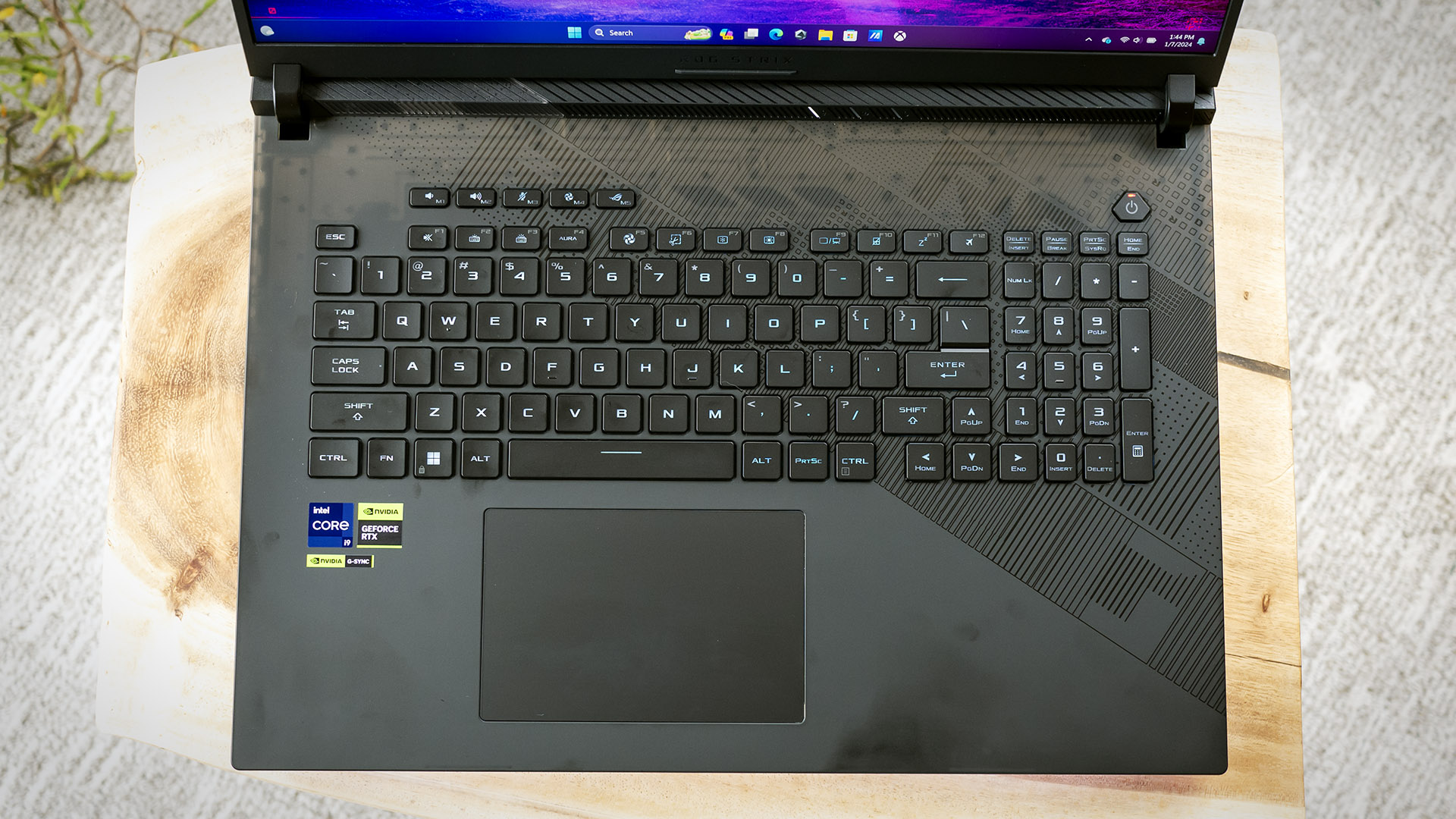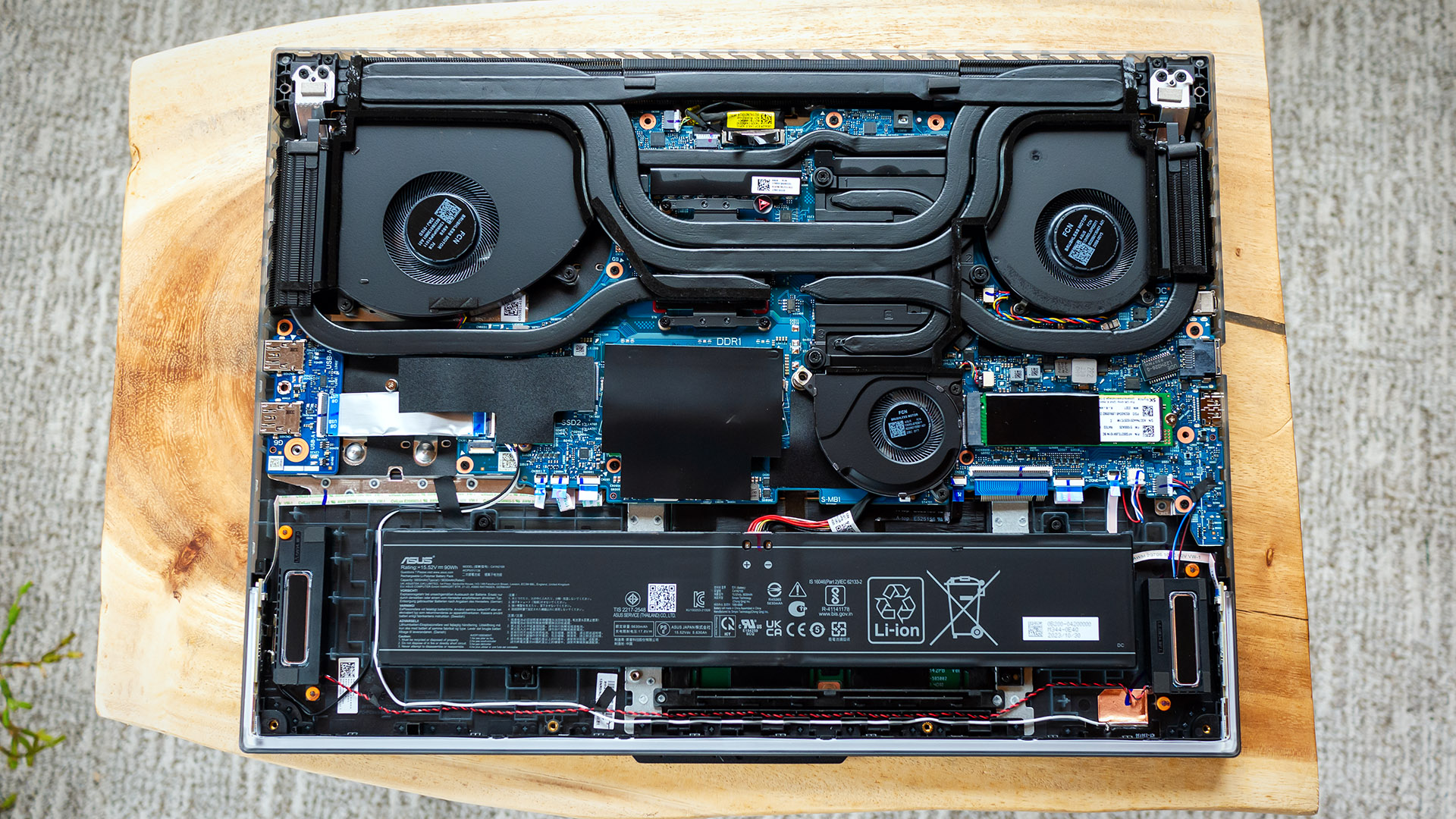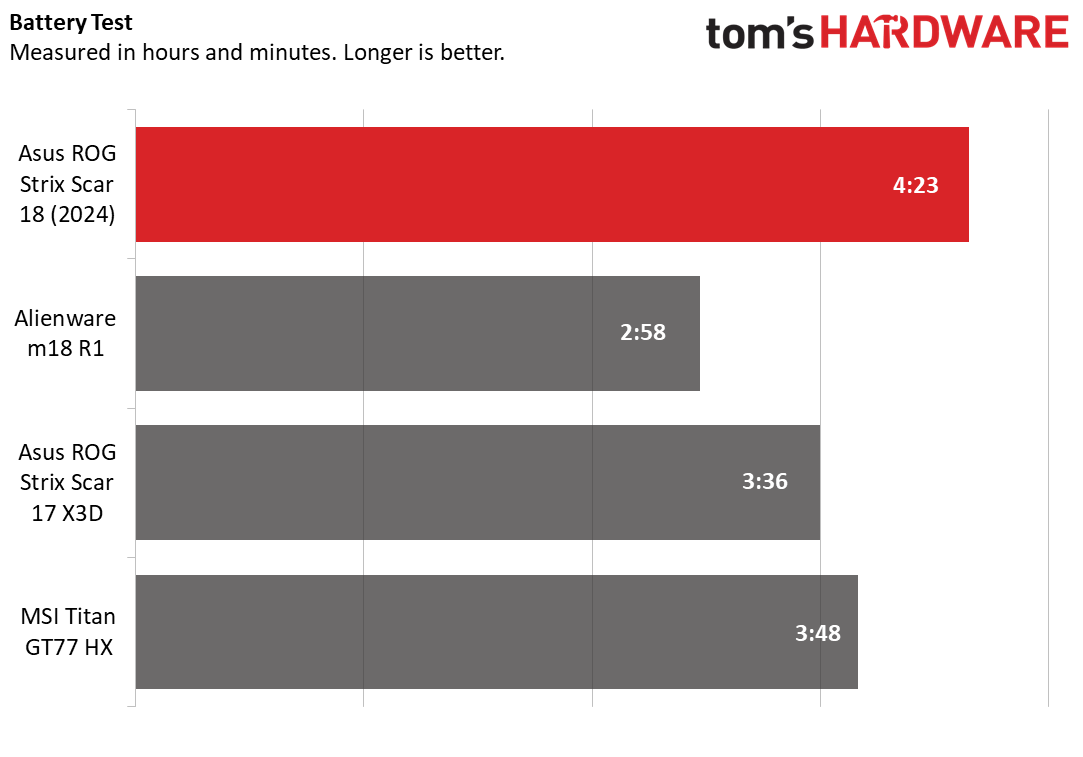Tom's Hardware Verdict
One of the largest gaming laptops, the refreshed ROG Strix Scar 18 makes waves with its stunning Mini-LED screen. It unfortunately doesn’t set itself apart in other ways, and thec14th generation Intel CPU hasn't done much for performance.
Pros
- +
Gorgeous Mini-LED screen
- +
Runs reasonably cool and quiet
- +
Dedicated macro keys
- +
Longer battery life than competitors
Cons
- -
Performance isn’t class leading
- -
Webcam is merely 720p
- -
Speakers need more volume
- -
No biometric features
Why you can trust Tom's Hardware
One of the largest gaming laptops, the 18-inch Asus ROG Strix Scar 18 has been refreshed for 2024 with Intel’s 14th generation Core HX-class processors and most importantly, a stunning mini-LED screen that looks sublime for gaming and everything else.
That said, for $3,899.99 as reviewed, we feel the Scar 18 could have done more to earn all those bucks. For instance, we would have liked to see some high-end additions, like a 1080p webcam and biometrics for security. Even its performance, though good, isn’t class leading, and that’s hard to swallow when you’re spending so much. If you prioritize the screen over everything else, though, the Scar 18 holds promise.
Design of the Asus ROG Strix Scar 18 (2024)
The ROG Strix Scar 18 for 2024 is physically the same as the 2023 version. This massive slab of a laptop measures 15.71 x 11.57 x 1.21 inches (WDH), so forget about fitting it on an airline tray table. It’s trimmer than the Alienware m18 R1 (16.15 x 12.59 x 1.05 inches) and lighter, at 6.8 versus 8.9 pounds.
The Scar’s aluminum lid has an RGB-backlit Republic of Gamers eye logo that won’t help it win a beauty contest, but it does look mean. RGB light bars spanning the front and rear of the chassis also help this laptop grab attention.
The RGB lighting is supposed to be controllable in the included Asus Armoury Crate app, but none of the presets seemed to do anything even after I disabled integration with Windows Dynamic Lighting. The latter provides RGB lighting control through Windows Settings, which is where I was able to toggle color, breathing, rainbow, wave, wheel, and gradient effects. Asus will likely solve this problem and allow RGB lighting changes through Armoury Crate, which is preferable since it has many more lighting presets.
Lid aside, the rest of the Scar’s chassis is plastic, which is common among gaming laptops. I noticed some flex when I grabbed the front corners, but nothing alarming. Something I didn’t like, though, was that the lid didn’t want to stay closed when I carried the laptop at my side; it’s as if the magnets holding the display shut weren’t quite strong enough.
The plastic chassis intriguingly goes from translucent near the lid to solid at the bottom (towards the touchpad). The sides of the chassis are also transparent. I’m on the fence about this unfinished cyborg look, but ultimately decided it’s more entertaining than a plain finish.
Get Tom's Hardware's best news and in-depth reviews, straight to your inbox.
The Scar’s port selection is average at best. Ports on the left include one Thunderbolt 4, one USB 3.2 Gen 2 Type-C (with support for DisplayPort, G-Sync, and 100-watt power delivery), HDMI 2.1 video output, 2.5 Gbps Ethernet, and a 3.5 mm audio jack. The barrel-style power jack is also here.
All that exists on the right edge is a pair of USB 3.2 Gen 2 Type-A ports. By comparison, the Alienware m18 R1 offers twice as many USB-A ports (four), a second Thunderbolt 4 port, and adds mini-DisplayPort and an SD card reader.
Asus ROG Strix Scar 18 (2024) Specifications
| CPU | Intel Core i9-14900HX (8 Performance and 16 Efficient cores, 2.4 GHz base clock, 5.8 GHz turbo, 65-watt base power) |
| Graphics | Nvidia GeForce RTX 4090 Laptop GPU (16GB GDDR6, 1,455 MHz boost clock, 175-watt maximum graphics power) |
| Memory | 32GB DDR5-5600 (2x 16GB) |
| Storage | 2TB PCIe 4.0 SSD |
| Display | 18-inch, 2560 x 1600, 16:10, Mini-LED, 240Hz, G-Sync, Dolby Vision, MUX switch |
| Networking | Intel Wi-Fi 6E AX211, Bluetooth 5.3 |
| Ports | Thunderbolt 4, USB 3.2 Gen2 Type-C (DisplayPort 1.4, G-Sync, 100-watt power delivery), HDMI 2.1, 2.5 Gbps Ethernet, 3.5mm headphone/microphone, 2x USB 3.2 Gen2 Type-A |
| Camera | 720p |
| Battery | 90 WHr |
| Power Adapter | 330 watts (barrel connector) |
| Operating System | Windows 11 Pro |
| Dimensions (WxDxH) | 15.71 x 11.57 x 1.21 inches (399 x 294 x 23.1 mm) |
| Weight | 6.61 pounds (3 kg) |
| Price (as configured) | $3,899.99 |
Gaming and Graphics on the Asus ROG Strix Scar 18 (2024)
The ROG Strix Scar 18 we’re testing is the 2024 model with a Core i9-14900HX processor (8 Performance and 16 Efficient cores, up to 5.8 GHz turbo), an Nvidia GeForce RTX 4090 (150W base power with up to 25W dynamic boost), and 32GB of RAM. The CPU is the only change from last year and saying that is a stretch since the 2023 model’s Core i9-13980HX is basically the same processor, but it tops out at 5.6 GHz.
My go-to game for stress-testing laptops remains Cyberpunk 2077. The game defaulted to the Ray Tracing Ultra preset with DLSS Super Resolution enabled, to which I also added DLSS frame generation. I saw between 100 and 115 fps in most situations at the native 2560 x 1600 resolution. The game looked and felt amazingly smooth.
I’m comparing this Scar to the Alienware m18 R1 (Core i9-13980HX, RTX 4090 150W, $3,599 as tested), the Asus ROG Strix Scar 17 X3D (AMD Ryzen 9 7945HX3D, RTX 4090 175W, $3,599), and the MSI Titan GT77 HX (Core i9-13950HX, RTX 4090 175W, $4,599). This is an exceptionally powerful group; only the Strix Scar 17 X3D differs on the CPU front with its special AMD chip. They otherwise all use a 150W+ RTX 4090, so we’ll expect similar results in the charts below.
I’m using the 1080p numbers for narration, but we also ran the tests at the Scar 18’s 2560 x 1600 native resolution. The other laptops have different native screen resolutions: the Alienware m18 R1 is 1920 x 1200, the Strix Scar 17 X3D is 2560 x 1440, and the MSI GT77 Titan HX is 3840 x 2160.
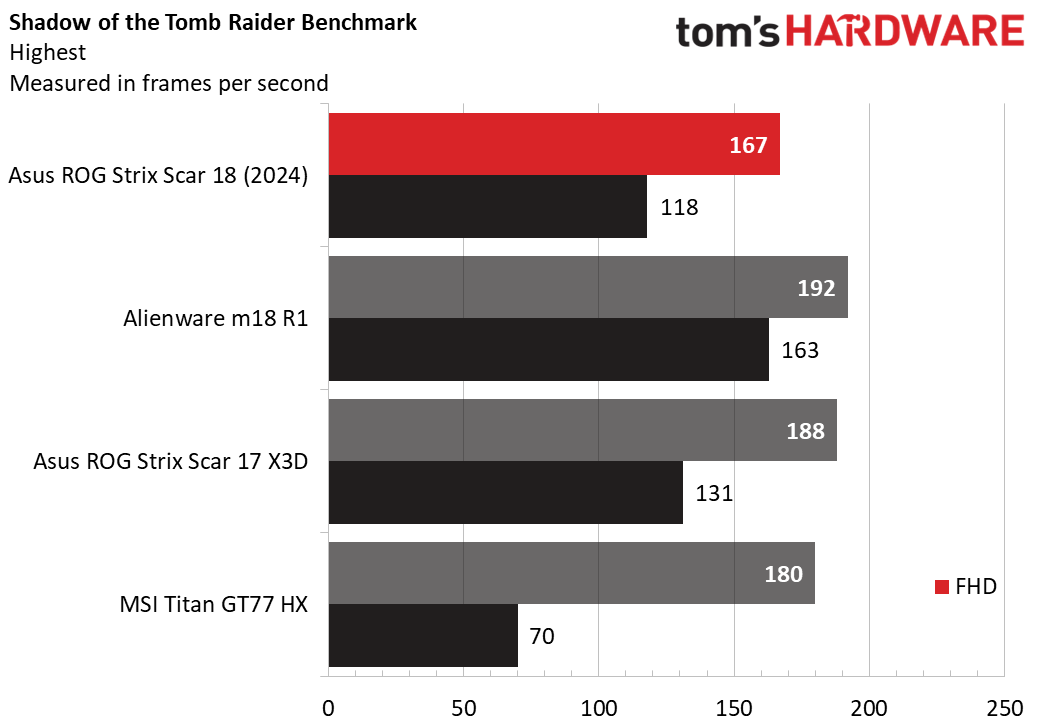
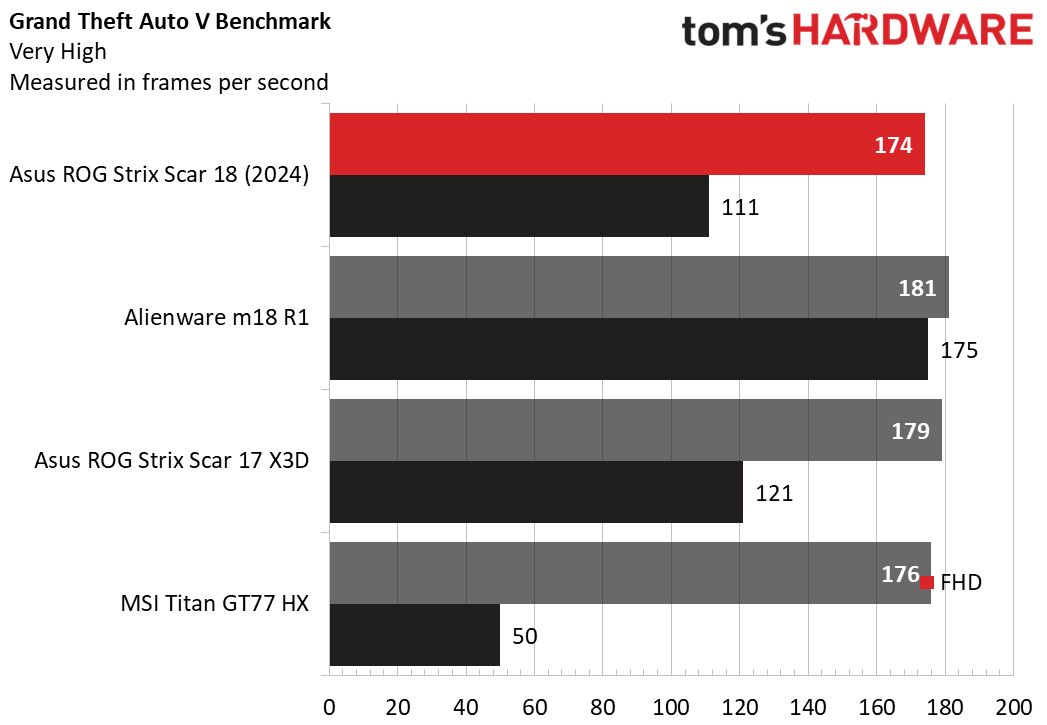

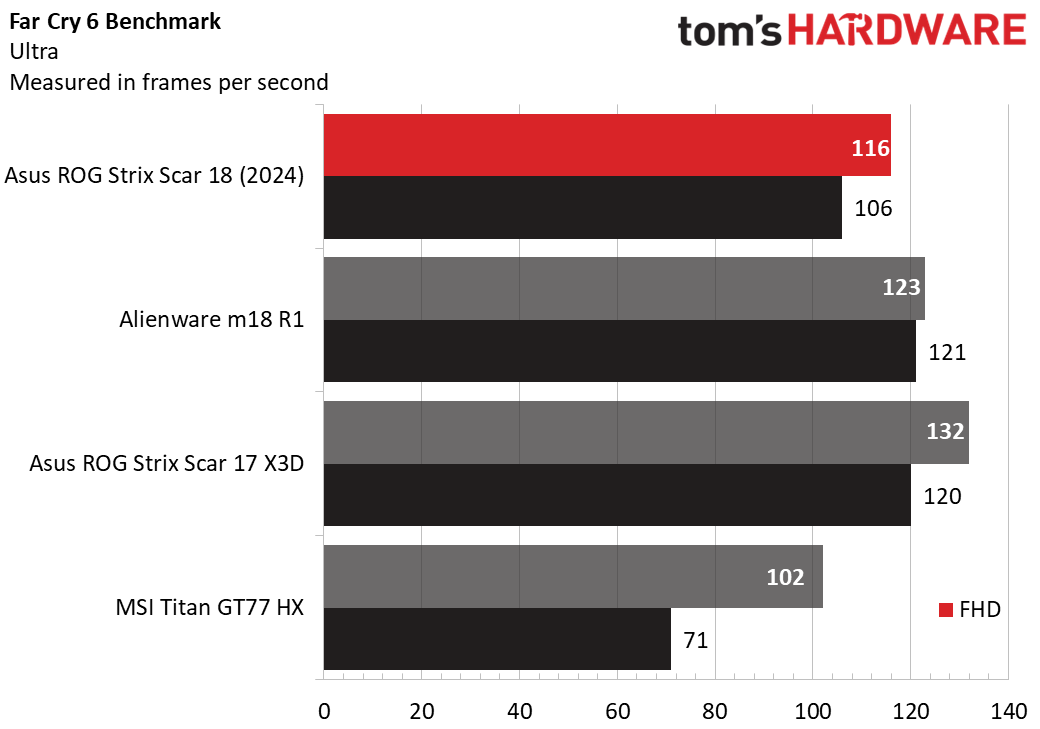
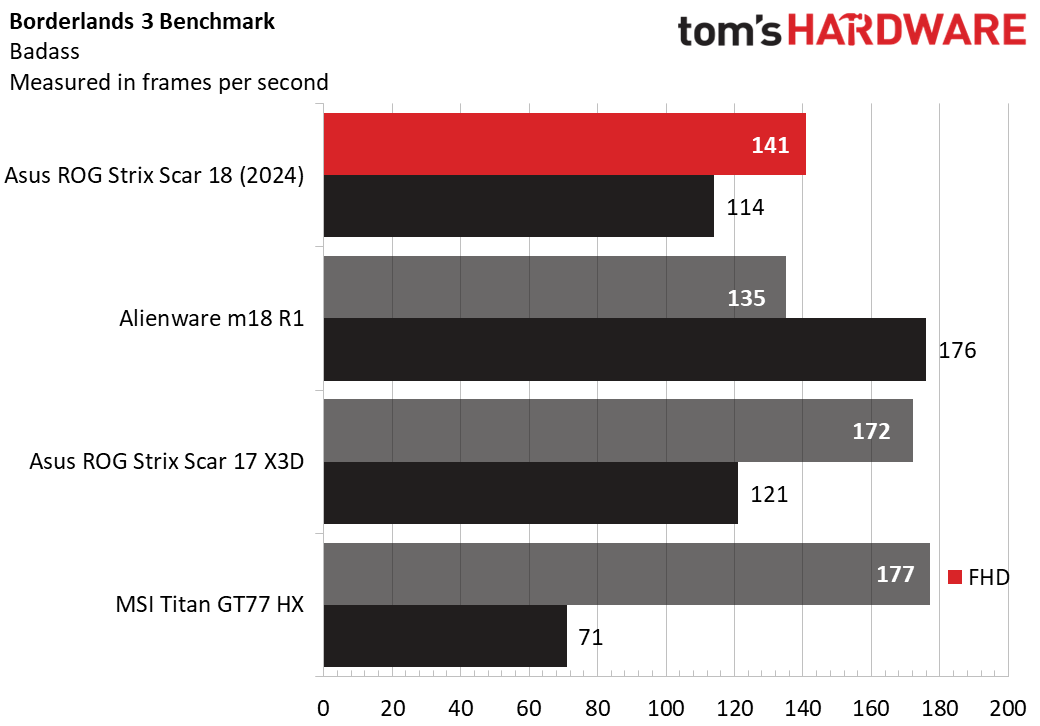
In Shadow of the Tomb Raider (Highest detail preset), the Scar 18 trailed the others with 167 fps at 1080p; the Alienware and Strix Scar 17 X3D did much better, with 192 and 188 fps respectively. The native screen resolution numbers were all over the place, but the Scar 18 didn’t see too significant of a drop, unlike the 4K-screened MSI.
The Scar 18 improved in Grand Theft Auto V (Very High) with 174 fps at 1080p, only trailing the others by a few frames. It also closed the gap at native resolution, with 111 to the Strix Scar 17 X3D’s 121 fps. The MSI’s high native screen resolution resulted in it scoring just 50 fps.
Far Cry 6 (Ultra) was another middle-of-the-road showing for the Scar 18, with 116 fps at 1080p to beat the Titan GT77 HX (102 fps), but well short of the leading Strix Scar 17 X3D (132 fps). At least its performance didn’t drop off too much at native resolution, to 106 fps versus 71 fps for the MSI. The Alienware continued to see the smallest drop between FHD and native, although it has a much lower native resolution.
The Scar 18 continued to trail in Red Dead Redemption 2 (Medium), with 121 fps at 1080p next to 135 fps from the leading Alienware m18 R1. The performance reduction going to native resolution was more severe, though the 81 fps it managed is perfectly playable. The same couldn’t be said about the MSI’s 48 fps at native resolution.
The Scar 18 also didn’t eke out a victory in our last test, Borderlands 3 (at the game’s “Badass” preset), achieving 141 fps at 1080p, nowhere near the 177 fps from the Titan GT77 HX or the 172 fps from the Strix Scar 17 X3D. The native resolution dropoffs were similar to what we saw in the other tests - again, not severe for the Scar 18.
Beyond these competitors, the new Scar 18 didn’t do better and often underperformed next to the 2023 model, though some of those differences might be software-related. (It’s been a year; drivers have changed and games have been patched.) Either way, though the 2023 model blew our doors off when we reviewed it, the competition has taken advantage of the time it’s had to catch up. Granted, the Scar’s performance won’t leave any gamer disappointed, but those looking for the pinnacle of performance would be better served with the Alienware m18 R1 or Asus’s own ROG Strix Scar 17 X3D.
We stress-test gaming laptops by looping the Metro Exodus benchmark at RTX settings 15 times to simulate half an hour of gaming. During the test, the Scar 18 averaged 127 fps across all runs. The Core i9’s P-cores ran at an average frequency of 4.05 GHz and 73.2 degrees Celsius while the E-cores averaged 2.87 GHz at 67.5 Celsius. The GeForce RTX 4090’s core clock averaged 1,864 MHz and it had an average temperature of 64.7 Celsius.
Productivity Performance on the Asus ROG Strix Scar 18 (2024)
Our 2024 ROG Strix Scar 18 has a Core i9-14900HX processor, 32GB of RAM, and a single 2TB Gen 4 SSD. This laptop should be able to handle any task.
Laptop makers can configure the default wattage of Core HX-class processors. The Scar 18 has the Core i9-14900HX set to 65W, but it can briefly consume up to 175W in PL2 using the “Turbo” preset in the Armoury Crate app. The default “Performance” profile which we used for testing caps PL2 at 120W.
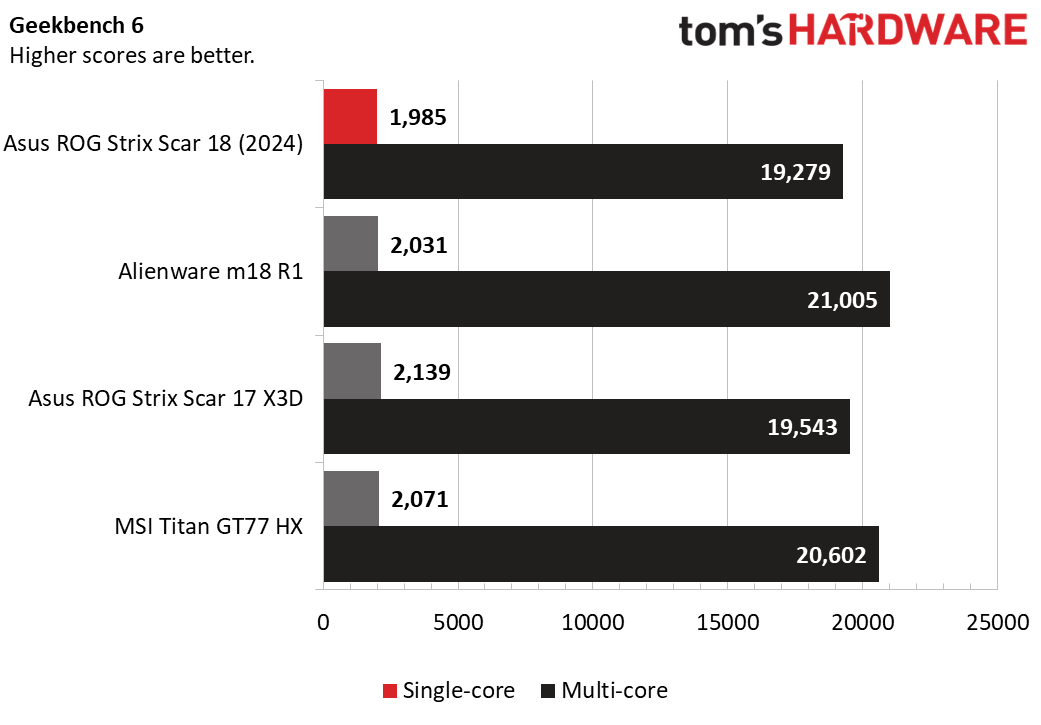

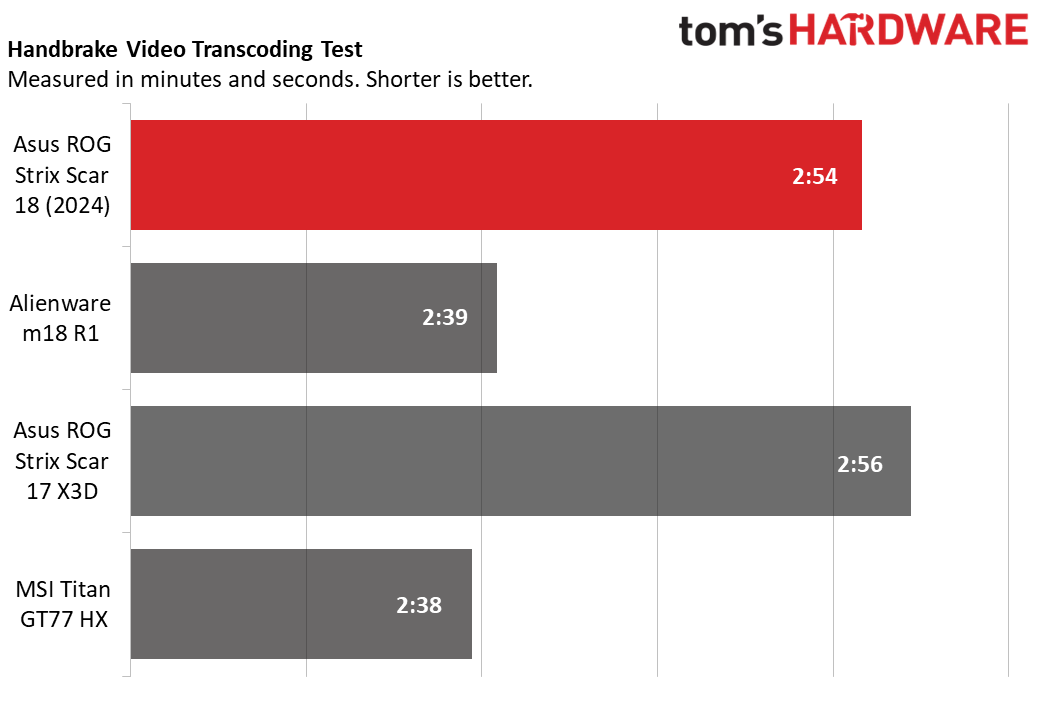

The CPU-focused Geekbench 5 test saw the Scar 18 in last place; its single-core score of 1,985 points was a shade below the next-slowest Alienware, with 2,031 points, and well back from the AMD-powered Strix Scar 17 X3D (2,139 points). It almost caught the latter in multi-core, with 19,279 points to 19,543 points, but the Alienware was untouchable with 21,005 points.
The Scar 18 also proved slow in our Handbrake video-transcoding test, completing it in 2 minutes and 54 seconds. It was only able to beat the AMD-powered Strix Scar 17 X3D by two seconds, remaining well off the pace set by the Alienware (2:39) and the MSI (2:38).
The Scar 18 redeemed itself in our 25GB data transfer test, averaging 2,259 MBps; the MSI did trivially better (2,300 MBps) while the Alienware and Strix Scar 17 X3D were way back at 1,532 and 1,417 MBps, respectively.
The numbers we saw from the Scar 18 could hardly be called slow – it blows the doors off ultraportable laptops, for instance – but at this price, every benchmark point counts.
Display on the Asus ROG Strix Scar 18 (2024)
The Scar 18’s main change for 2024 is its screen; this time around, it has a 2560 x 1600 mini-LED panel that Asus dubs “ROG Nebula HDR”. The screen has 2,304 dimming zones to reduce halo effects that can afflict mini-LED displays, and I indeed noticed none. Asus rates this display for 100% of DCI-P3 color and an astounding 1,100 nits peak brightness. Gamers will appreciate its healthy 240 Hz refresh rate, low response time (3 ms GTG), and Nvidia G-Sync support. Hardcore gamers will be glad to know this laptop also has has a MUX switch for the lowest latency which can be toggled in Armoury Crate.
I’m convinced nothing can look bad on this screen. From gaming to media to simply typing this review, the picture is exceptionally vivid and bright. The space scenes in Christopher Nolan’s Interstellar emphasized the HDR effects of mini-LED, with the stars and spaceships standing out beautifully against an inky black background. I was also guilty of stopping and staring at the many neon signs and brightly-lit storefronts in Cyberpunk 2077’s Night City.
Though the Scar 18’s Mini-LED display averaged an admirable 427 nits of brightness, the MSI did much better (511 nits). That said, mini-LED displays won’t reach their peak brightness on the entire display, only in parts as we found when we recorded 1,170 nits in our HDR brightness tests. Therefore, while this display might not top a “normal” display when the screen is all white, it certainly will for just parts of the screen.
The Scar 18 also didn’t win out against the MSI in color, but the numbers seen here – 78% DCI-P3 and 119% sRGB – are still very good for a gaming laptop. The Alienware and Strix Scar 17 X3D had about the same DCI-P3 coverage, at 77.4% and 78% respectively, but they weren’t nearly as bright, being below 350 nits.
Keyboard and Touchpad on the Asus ROG Strix Scar 18 (2024)
The keyboard is an area where I think Asus could have done better. Unfortunate layout choices created some fundamental problems; for instance, the arrow key cluster is forced into the main keyboard instead of being separated out, compromising the right Shift and the number pad ‘0’ keys. The number pad strangely has undersized keys despite the massive width of this laptop, an unfortunate choice that we've also seen others, like MSI, make on large laptops.
On the plus side, the keyboard does have five programmable hot keys at top left. You can easily create macros in the Armoury Crate app in the Device section, including the time delay between keystrokes. Assigning macros to the hotkeys could have been more intuitive; in the Device section, you must select the ROG Strix Scar 18 and then Customizable Hotkeys, so the option is basically hidden. A link on the Macro editor to quickly assign them would have made this a lot easier. You can, of course, save your Armoury Crate settings in multiple profiles.
The typing experience is average. I didn’t have any functional problems, hitting 112 words per minute with 99% accuracy in MonkeyType, which is close to as good as I can do. But despite the 2 mm key travel, the keys feel lifeless. I’d like to see a mechanical keyboard option as Alienware offers on its m18. I also thought the backlighting could have been brighter and sharper.
The Scar 18’s touchpad, on the other hand, is excellent, with a reasonably (but not overly) sized matte surface. Physical clicks, accomplished by pressing the pad, are sure and quiet.
Audio on the Asus ROG Strix Scar 18 (2024)
The Scar’s twin speakers are behind the vent holes on either side of the display hinge. Despite their optimal user-facing orientation, I was surprised at the recessed sound quality and lack of volume to the point where I wondered if any settings might have been misconfigured. Changing the Dolby Atmos equalizer to “Dynamic” in the included Dolby Atmos app seemingly boosted the volume in Phil Collins’ “Don’t Lose My Number”, but not enough to change my opinion. The system’s only redeeming quality is bass, but the low speaker volume makes it hard to appreciate.
The speakers seemed to do better in gaming; voices, gunshots, and explosions in Cyberpunk 2077 came through reasonably clear, though small details were hard to hear over the laptop’s fans (which aren’t particularly loud for a gaming laptop).
Upgradeability of the Asus ROG Strix Scar 18 (2024)
Eleven Philips-head screws secure the ROG Strix Scar 18’s bottom panel. The four along the front edge are shorter in length, so be sure to keep them separate. The rightmost screw along the front edge and the center screw in the main panel are retainer-style and don’t come out.
Removing the bottom panel is challenging since there is practically no gap between the panel and the chassis. I made my entry next to the retainer screw on the front edge using a plastic trim tool and worked my way around the side and front edges, at which point the rest of the clips were easy to pop free.
Upgradeable items include two DDR5-5600 SODIMM slots and two M.2 2280 Gen 4 slots. The 90 WHr battery can also be upgraded.
You should obviously shut off the laptop prior to doing any upgrades, but just in case you forget to do that, Asus has placed an optical sensor under the bottom panel that automatically shuts the laptop off if the bottom panel is removed. It also prevents the laptop from turning on if the panel isn’t put back in place.
Battery Life on the Asus ROG Strix Scar 18 (2024)
Battery life might seem like an afterthought on a huge gaming laptop, but the Scar 18 has enough juice to let you watch a long movie off the plug. It lasted 4 hours and 23 minutes in our battery life test, which consists of web browsing, video streaming, and OpenGL graphics tests at 150 nits of screen brightness. The next longest-lasting laptop was the MSI (3:48) while the Alienware had the shortest life (2:58).
Heat on the Asus ROG Strix Scar 18 (2024)
We measure gaming laptop surface temperatures while running the Metro Exodus benchmark at RTX settings. During the benchmark, the laptop reached just 79 degrees Fahrenheit between the keyboard G and H keys while the touchpad was basically room temperature (68 F). The maximum temperature on the laptop’s underside was 102 F. Impressively, no part of this laptop felt more than lukewarm to the touch.
Asus seems to go the extra mile when it comes to cooling, applying Conductonaut Extreme Liquid Metal on the CPU and GPU and putting dust filters over the fans. The fans are audible under load but they don’t have any whine or other annoying characteristics.
Webcam on the Asus ROG Strix Scar 18 (2024)
The ROG Strix Scar 18’s webcam on top of its display has a 720p resolution that will make you feel like you’re back in 2010. We expect 1080p at the minimum, and preferably 1440p on a laptop of this caliber. Asus needs to step up its game here.
I should also note the webcam lacks a privacy shutter and doesn’t support infrared for Windows Hello facial recognition. This laptop has no biometric features, not even a fingerprint reader, so you’ll be stuck typing passwords.
Software and Warranty on the Asus ROG Strix Scar 18 (2024)
The most important included app on the Scar 18 is Armoury Crate, which provides performance profiles, system settings, and macro editing and key assignment. It should also provide RGB lighting control, though I noted I had trouble with that; the only way I was able to control the laptop’s lighting was by using Dynamic Lighting in the Windows Settings app.
Asus also includes a MyAsus app for updates and access to support. While I don’t remember this app requiring a sign-in on previous Asus laptops I tried, it seemed to require an account now.
The Dolby Access app is also important since it controls the Atmos equalizer, which works for headphones, too.
I was disappointed to see a 30-day trial of McAfee installed. (I promptly removed it.) The standard Windows apps are also included, such as Spotify.
Asus ROG Strix Scar 18 (2024) Configurations
We reviewed the Scar 18 as model G834JYR-XS97, which is $3,899.99 with a Core i9-14900HX, a GeForce RTX 4090, 32GB of RAM, a 2TB SSD, Windows 11 Pro, and the 2560 x 1600 Mini-LED screen. Asus will also be offering model G834JYR-XS98 for $3,999.99, with 64GB of RAM as the only difference. The systems should be on sale later in January.
Bottom Line
The ROG Strix Scar 18 is sure to delight gamers looking for a large and exceptionally high-quality screen. Adding in its powerful components, this massive laptop is the very definition of a desktop replacement. It even gets usable battery life off the plug.
Beyond its screen, though, the Scar 18 leaves us with mixed feelings. Its performance is doubtlessly good enough for anything, but despite an upgrade to Intel’s 14th generation CPU, it usually ended up trailing the 13th generation chips we tested in competing laptops, namely the Alienware m18 R1 and the MSI GT77 Titan HX. Those laptops, along with Asus’s own ROG Strix Scar 17 X3D, also proved faster in our gaming tests, too. The Scar 18 is just as expensive as those laptops.
We also thought Asus could have included a wider port selection, biometric features (let’s face it, even budget laptops often include fingerprint readers), and a higher-resolution webcam. 720p isn't acceptable on a laptop that costs almost $4,000.
In short, the Scar 18 offers a great screen, but Asus needs to go the extra mile in some other areas. This Scar 18 is nonetheless worth considering if screen quality is your top priority, but some of our 13th Gen picks like the Titan and Alienware m18 are still strong options, and there are plenty more 18-inchers hitting our testbed soon.
MORE: How to Buy a Gaming Laptop
MORE: Best Gaming PCs
MORE: Best Ultrabooks and Premium Laptops

Charles Jefferies is a freelance reviewer for Tom’s Hardware US. He covers laptop and desktop PCs, especially gaming models.
-
razor512 The laptop would look better with a cleaner design and no webcam, and instead just have a clean top bezel, and at most include a USB webcam if a user really needs to use one.Reply -
Tom Sunday With the cost of this particular 2024 ‘Strix Scar 18’ (including sales tax) ranging around $4,400…who would buy such a laptop this late in the season? Asus in fact did not go the extra mile as not offering a 4TB dedicated gaming SSD, a separate 2TB SSD boot drive, a Gen 5 PCIE slot and DDR5-6000 cabapilites…all naturally out of the box! Getting a more beefy WHr battery as part of the refresh would also be nice. Besides all of this…an all new 15th Gen Core and new mandatory much more capable MB’s are waiting in the wings! Long story short…this Scar 18 model touted to be a huge gaming laptop without all of the real goodies, will practically be outdated and outclassed in less than 6-7 months.Reply -
Sleepy_Hollowed Oh boy, that's one expensive laptop.Reply
I mean, outside of the display, which is honestly really nice, it's a bit too much, even compared to a MacBook Pro with similar specs/
Though if you do need the display on the go I guess it's a real contender, though that'd be very niche these days. -
subspruce Reply
You need a briefcase to carry it thoSleepy_Hollowed said:Though if you do need the display on the go I guess it's a real contender, though that'd be very niche these days. -
Sleepy_Hollowed Reply
If you’ve flown in the last 10 years, you need a pelican case for your electronics at this point so yep, close enough.subspruce said:You need a briefcase to carry it tho


